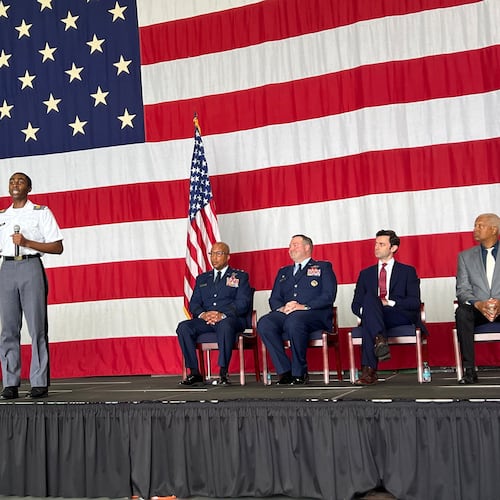I remember hearing in 2013 that George W. Bush had taken up painting. It sounded like a surprisingly artsy, but pleasant hobby for a man who had finished two terms in the White House and was finally done with politics after decades in the game.
Winston Churchill had been a painter, too, and a good one. While Churchill’s art often depicted European landscapes and friends’ estates, a new exhibit of Bush’s paintings at the Atlanta History Center is a not-at-all subtle call for comprehensive immigration reform, something he tried and failed to enact during his second term as president.
The exhibit of Bush’s art is called, “Out of Many, One,” the English translation of the E Pluribus Unum motto on the Great Seal of the United States. It includes 43 portraits from the 43rd president, which depict American immigrants selected by Bush for their achievements on behalf of their adopted country.
Several of the faces are famous. Henry Kissinger and Madeleine Albright were both secretaries of state whose families fled dictatorships and oppression, Kissinger from Nazi Germany and Albright from communist Czechoslovakia, and created homes in America.
Professional golfer Annika Sorenstam, baseball great Albert Pujols, and former Pepsi CEO Indra Nooyi are also included. Bush celebrates each for giving much more than they ever required as new arrivals.
Along with the well-known portraits, Bush also painted the faces of the lesser-known. Gilbert Tuhabonye, a runner from Burundi, fled the Tutsi-Hutu war and applied to compete on the track team for Abilene Christian University. He later moved to Austin, Tex., to work in a running store and started a runners’ club there. One of the runners was college-aged Jenna Bush, who called her dad at the White House one day to tell him how inspiring Gilbert’s story was to her.
Alfredo Duarte waded through the neck-high waters of the Rio Grande when he was 17, having been on his own since he was 14-years-old. Once in America, Duarte learned English, worked several jobs, and started a business selling tomatoes. He is now a Dallas-based CEO.
The collection includes immigrants from across the globe, and from different faiths, races and backgrounds.
Ezinne Uzo-Okoro is a NASA engineer who left Nigeria for Washington, D.C. when she was 16.
Tony George Bush was an Iraqi interpreter who embedded with the Marines during the second war in Iraq. American Marines nicknamed him “Tony” and he legally changed his name to “George Bush” after he moved to Texas and got a job at George Bush Intercontinental Airport. He calls becoming an American citizen, “the best thing that ever happened to me.”
Along with each painting, Bush has recorded a biography, with the former president describing the humble beginnings, harrowing challenges, and soaring, if not always celebrated, achievements of each immigrant’s story. Many portraits also include the voices of the subjects, describing their feelings about America in their own words.
Joseph Kim, a North Korean refugee, says that his American dream was not just about meritocracy, “but also about the generosity and grace of strangers.” Bush explains that the “funny, friendly” Kim was the first person he painted because Kim also works downstairs from him as an assistant at the Bush Institute.
Along with the individual stories, the exhibit includes walls of timelines, data and graphics. It describes the contributions of other immigrants (everything from the design of the White House to inventions like ATM machines, N-95 masks, and Zoom.)
It also illustrates the incredible labyrinth required to immigrate legally to the United States and the years, sometimes decades-long wait times, it requires.
In a coffee table book that accompanies the exhibit, Bush calls for a “robust, efficient immigration system.” And he suggests a combination of increased visas, secure borders, accessible channels for refugees, temporary work visas, and citizenship for DREAMers to improve and reform the current mess we have.
It’s a position paper inside a portrait gallery and the position couldn’t be much more different than the approach of today’s GOP leaders.
Where Bush personalizes immigrants and celebrates their potential, former president Donald Trump demonized immigration and dehumanized immigrants from the very beginning of his first run for president.
When Mexicans cross the Southern border, he famously said in his announcement speech for president in 2015, “They’re bringing drugs. They’re bringing crime. They’re rapists. And some, I assume, are good people.” Some.
Trump continues to this day to claim he built that wall between Mexico and the United States. Since the wall was never built, he at least doesn’t have to pretend that Mexico paid for it, as he promised his earliest crowds he would make happen.
But the roaring approval that conservative voters gave to Trump has pushed the entire GOP to the right on immigration.
At a press conference at the Georgia capitol earlier this week, former Sen. David Perdue blamed his GOP primary target, Gov. Brian Kemp for not doing more to stop illegal immigration in Georgia. Kemp has, in fact, traveled to the Southern border multiple times to push a tough-on-the-border message, but the truth is that Perdue had more say over immigration when he was a senator than he or Kemp ever would as governor.
It’s hard to see where this George Bush, never accused of being a RINO in his day, would fit into the current version of his party.
But by tackling the issue, he’s providing a road map forward that few in either party have the courage to follow right now.
That the former president has wrapped it in a collection of portraits, without even signing his name to the paintings, starts a conversation that unsuspecting visitors may not even know they’re having when they head to the Atlanta History Center to see if George Bush can really paint.
The answer is yes, he can really paint. And he’s not really done with politics after all.
About the Author
Keep Reading
The Latest
Featured



